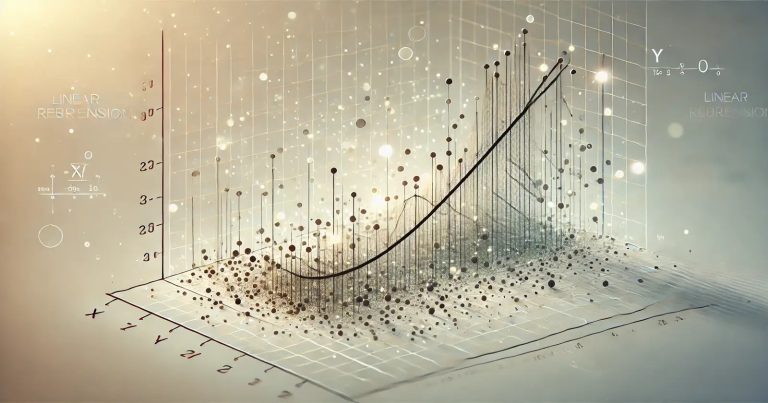In ML, linear regression predicts future values using past data. It constructs an equation in a straight line that mathematically expresses the relation between what goes in and what comes out. What is the linear regression in machine learning used for? A linear regression in machine learning is used to find trends and make relevant predictions utilizing historic data.
It is one of the simplest and most commonly used machine learning algorithms. All the possible areas in which you can use, such as business, science, and weather forecasting. It is a good choice when you have knowledge of the data pattern.
Linear Regression Machine Learning
In this section, you will explain the workings of linear regression in machine learning for freshers. It describes how it generates predictions through data points and basic mathematics.
What is Linear Regression?
A linear regression is a method that fits a straight line to our points. This line gives us a relation between the input and the output. The equation of the line is:
Y = mX + b
Here, Y is the output, X is the input, m is slope and b is the intercept.
The algorithm returns best fit values for m, and b that allow the line to fit the data. It utilizes least square method. That means it selects a line that minimizes the difference between actual and predicted values.
You train your model based on data. Then the model learns the patterns. You get it new input, and it gives you output essentially based on where it learned the line after training.
Why is Linear Regression Important?
It helps in:
- Making predictions about sales, prices, or trends in the future.
- The relationships between two factors affect one another
- Making decisions using data.
This is why this algorithm is the algorithm with which most people start machine learning. This will lay the foundation for more advanced models later. If you are a beginner, learn it thoroughly before moving on to the ML skills.
Simple Linear Regression in Machine Learning with Real-Life Examples
Now let’s grasp what is simple linear regression in machine learning. This is the most basic form. When you have one input and one output, it works.
Explanation of Simple Linear Regression
The simplest case is simple linear regression which fits a straight line between two variables. If you want to predict how much a student gets score by how many hours he/she studies, this method works great.
Consider that the input (X) is study hours and the output (Y) is the exam score. The line it draws is the expected score function based on hours studied.
It accomplishes this by discovering the slope and intercept that cause the line to fit best. Loss functions such as Mean Squared Error are used to see how close its guesses come to ground truth values. Then it tweaks slope and intercept until it finds the best fit.
An example of using Linear Regression in Machine Learning
For example, in machine learning we have the following linear regression:
| Study Hours (X) | Exam Score (Y) |
| 1 | 50 |
| 2 | 60 |
| 3 | 65 |
| 4 | 70 |
| 5 | 75 |
The algorithm will fit a straight line through these points. For instance, if a new student studies for 6 hours, it can predict a score of 80.
When you have clean data and only one factor drives the output, simple linear regression does well. When multiple factors interact, that is not supportive.
How to Use Multiple Linear Regression in Machine Learning?
Machine learning multiple linear regression: when more than one input has an effect on the outcome It makes you understand how many something together can have an impact on the output.
How Multiple Linear Regression Works?
So where the original formula had one X, we now have many. The formula becomes:
Y = b0 + b1X1 + b2X2 + … + bnXn
Each X is an input feature. Each b is the weight/effect of that feature on the outcome. The model trains this data and learns the optimal values of these weights.
Multiple Linear Regression Example
We’ll say we are trying to predict housing prices. Things like size of the house, number of bedrooms, and location all come into play.
| Size (sqft) | Bedrooms | Distance to City | Price (Y) |
| 1000 | 2 | 5 km | ₹30 lakhs |
| 1200 | 3 | 3 km | ₹45 lakhs |
| 900 | 2 | 7 km | ₹28 lakhs |
| 1500 | 4 | 2 km | ₹60 lakhs |
Now the algorithm will adjust a model to fit all the inputs. It understands the impact of every input on price, and automatically gives correct predictions.
Multiple regression gives more power than simple regression. It suggests that real-world problems don’t always have a single cause.
Types of Machine Learning Linear Regression
Now, let’s understand what the types of linear regression in machine learning? Each one applies to different data conditions.
Simple Linear Regression
It consists of one input and one output. It fits a straight line. It Particularly applies to simple data with one main impulse.
Multiple Linear Regression
It uses multiple inputs to predict the output. It embeds a plane or hyperplane in higher dimensionality. It is applicable for data with a large number of factors.
Polynomial Regression
This is an extension. It is molded around curves, not lines. It is useful whenever the data is not linear but still follows some sort of a trend.
Ridge Regression
This technique places a penalty on the loss function. It prevents overfitting when the model becomes complex.
Lasso Regression
It also adds a penalty, like Ridge. However, it can also make certain input weights zero. It eliminates unessential features.
Use in Real Life
All these variants solve different real world problems. So when your data has too many variables or has the curves, choose wisely.
In machine learning, linear regression types give you freedom. You can choose the appropriate approach for your data.
Relevance to ACCA Syllabus
The ACCA syllabus is widely regarded as very rich in financial analysis, forecasting, and data-driven business decision-making. By supporting predictive modeling processes, trend analysis, and budgeting, linear regression in machine learning is instrumental in forming the basis of financial planning and strategic decision-making. ACCA students with an understanding of regression can tell how much of an entity’s costs, revenues, and corporate performance in its reports is explained by data analysis.
ACCA Questions on Linear Regression in Machine Learning
Q1. What is the basic application of linear regression in finance?
A) Determine tax liabilities
B) To identify historical patterns and use them to predict financial values
C) For bookkeeping to calculate asset depreciation
D) To audit internal controls
Ans: Estimate future economic values based on historical patterns
Q2. In a simple linear regression, in which direction does the slope going?
A) The fixed cost
B) The rate of change is not fixed
C) The interest rate
D) The balance sheet total
ANS: B) Continuously changing at a variable rate
Q3.: What type of variable does linear regression predict?
A) Categorical
B) Binary
C) Continuous
D) Nominal
Ans: C) Continuous
Q4. The use of linear regression in business contexts is largely covered in which ACCA paper?
A) Taxation (TX)
B) Financial Reporting (FR)
Strategic Business Leader (SBL) (C)
D) PM (Performance Management) It is performed on the selected objects.
Ans: ( D ): Performance Management ( PM )
Q5. What is the most important assumption in linear regression?
A) Data must be seasonal
B) Homoscedasticity of residuals
C) IVs should be negative
D) Output should be binary
Ans: B) Residuals have constant variance
Relevance to US CMA Syllabus
These include performance management, cost analysis, and budgeting in the US CMA syllabus. Predictive analysis, variance, cost behavior, linear regression in machine learning This is where candidates use regression to predict the expense, revenue trends, and profitability by introducing different scenarios.
Linear Regression Machine Learning CMA Questions
Q1. What is the dependent variable in regression analysis?
A) The known outcome
B) The expected value based on your given inputs
C) The control factor
D) The fixed constant
ANS: A) The known outcome
Q2. Where Regression for budgeting and forecasting fall in CMA syllabus?
A) Part 1 — Financial Planning, Performance management, and Analytics
B) Part 2 — Strategic Financial Management
C) Ethics in Business
D) Taxation and Reporting
Ans: A) 1 – Business Financial Planning, Performance and Analytic
Q3. What R-squared is telling you in regression?
A) The level of risk
B) Variance explained by the model
C) Interest coverage ratio
D) The depreciation schedule
Ans: B) Proportion of variance accounted for by the model
Q4. The slope has a large p-value (slope p-value = {p_value}) as we see in the regression output. What the hell is a manager supposed to make of this?
A) The outcome is significantly predicted by the variable
B) The variable is not statistically significant
C) Het modelregressie is ideaal
D) The data set is incomplete
Ans: B) Variable is not significant
Q5. A linear regression in variance analysis can be used by managers, and that I know.
A) To compute tax rates
B) To measure production failures
C) Computing behavioral changes in costs with the volume
D) Prepare Legal Statements
Ans: C) To predict how the cost evolves with volume
Relevance to CPA Syllabus
Topics on CPA audit data analytics, financial forecasting and indicators, and management accounting concepts. Machine Learning −− With transaction analysis, auditors can use machine learning algorithms If they will use linear regression and other ML algorithms can identify patterns and spot abnormal transactions. Also, it aids on the data-driven assurance and financial forecasting including Business Environment and Concepts or BEC part.
Linear Regression Machine Learning CPA Questions
Q1: Analytical procedures used in a CPA audit are designed to test the sample from a population in the audit which can lower detection risks. Which type is this?
A) Predictive Analytics
B) Descriptive Analytics
C) Diagnostic Analytics
D) Prescriptive Analytics
Ans: B) Descriptive Analytics
Q2: You are an analyst investigating the cause of suspicious peaks in sales. You might use:
A) Prescriptive Analytics
B) Descriptive Analytics
C) Diagnostic Analytics
D) Predictive Analytics
Ans: C) Diagnostic Analytics
Q3: How does a CPA use analytics to look at future cash flow projections?
A) Descriptive Analytics
B) Prescriptive Analytics
C) Diagnostic Analytics
D) Predictive Analytics
Ans: D) Predictive Analytics
Q4: This analytics allows CPAs to recommend changes to internal controls.
A) Descriptive Analytics
B) Diagnostic Analytics
C) Prescriptive Analytics
D) Predictive Analytics
Ans: prescriptive analytics
Q5: Line chart is an example of showing the expense trend over atleast month/ quarter/ week which is time dimension.
A) Predictive Analytics
B) Descriptive Analytics
C) Diagnostic Analytics
D) Prescriptive Analytics
Ans: B) Descriptive Analytics
Relevance to CFA Syllabus
Usually, you have provided some hints of kinds of data analytics in relation to the CFA Syllabus. Areas like portfolio management, equity investments, and financial reporting evaluation are at pretty high levels of data analytics respectively here – in queue to become CFA candidates. In the current situation, your analytics are needed, to have a value for the asset, risk management, and return forecasts. These concepts are the halm of modern finance, in which an invest decision is viable among predictive model and big data comprehension.
Linear Regression Machine Learning CFA Questions
Q1:Which type of data analytics uses historical data to make forecasts about future outcomes or trends?
A) Prescriptive Analytics
B) Descriptive Analytics
C) Predictive Analytics
D) Diagnostic Analytics
Ans: C) Predictive Analytics
Q2: What is the CFA still becoming by analyzing the performance of the bonds?
A) Descriptive Analytics
B) Prescriptive Analytics
C) Predictive Analytics
D) Diagnostic Analytics
Ans: A) Descriptive Analytics
Q3: Are we able to identify existing such analysis or analytics that may help provide a base level explanation for the fund level return movement.
A) Predictive Analytics
B) Descriptive Analytics
C) Diagnostic Analytics
D) Prescriptive Analytics
Ans: C) Diagnostic Analytics
Q4: For CFA we provide an optimization model This involves:
A) Prescriptive Analytics
B) Descriptive Analytics
C) Diagnostic Analytics
D) Predictive Analytics
Ans: A) Prescriptive Analytics
Q5: Monthly investment risk-adjusted returns chart is created with:
A) Predictive Analytics
B) Descriptive Analytics
C) Prescriptive Analytics
D) Diagnostic Analytics
Ans: B) Descriptive Analytics


